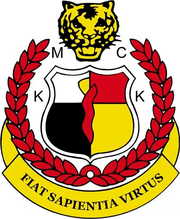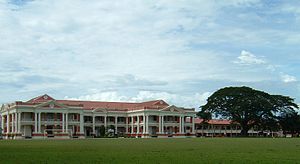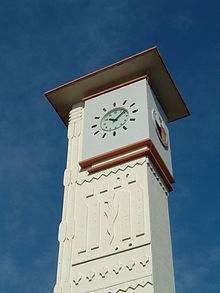- Malay College Kuala Kangsar
-
Malay College Kuala Kangsar
(Malay) Kolej Melayu Kuala Kangsar Fiat Sapientia Virtus (Manliness Through Wisdom)
Fiat Sapientia Virtus (Manliness Through Wisdom)Location Kuala Kangsar, Perak, Malaysia Information Type Public[disambiguation needed  ] all-boys boarding school
] all-boys boarding schoolEstablished 2 January 1905 Founder Sultan Idris (Perak)
Sultan Sulaiman (Selangor)
Sultan Ahmad (Pahang)
Yang di-Pertuan Besar Mohd Shah (Negeri Sembilan)Principal Mr. Anand b. Baharuddin Grades Form 1 - Form 5 Number of students 650 Medium of language Malay Colour(s) Yellow, red, black, white Yearbook The Malay College Magazine Website Official website 
The Malay College Kuala Kangsar (Malay: Kolej Melayu Kuala Kangsar, abbreviated as Malay College, MCKK) is a residential school in Malaysia. It is an all-boys and all-Malay school located in the royal town of Kuala Kangsar, Perak. It was awarded the prestigious Cluster School of Excellence title by the Ministry of Education (Malaysia).
Contents
Coat of arms
The shield is quartered, coloured white (argent) in the first quarter, red (gules) in the second, black (sable) in the third and yellow (or) in the fourth.
The colors represent the four Houses into which the students are grouped; Idris (white), Sulaiman (red), Mohd Shah (yellow) and Ahmad (black). The Houses are named in honor of the four Sultans who founded the College.
In the middle of the shield is a red kris, a traditional Malay dagger. On top of the crest is a head of a tiger which is the symbol of the Federation of Malaya. Surrounding the left and right side of the shield are laurel wreaths symbolizing excellence. The school motto is Fiat Sapientia Virtus, which is Latin for Manliness Through Wisdom.
History
Malay College Kuala Kangsar (MCKK) is the first fully residential school in Malaysia. Established on 2 January 1905, it was originally known as the Malay Residential School of Kuala Kangsar.
The school was the brainchild of Mr R J Wilkinson, then Inspector of Schools for the Federated Malay States. In a letter to the Resident-General dated 24 February 1904 he wrote about "establishing at a suitable locality in the F.M.S., a special residential school for the education of Malays of good family and for the training of Malay boys for admission to certain branches of Government service".
Its formation was supported by the then Rulers of the Federated Malay States namely Sultan Idris Murshidul ‘Adzam Shah I of Perak, Sultan Alaiddin Sulaiman Shah of Selangor, Yam Tuan Tuanku Muhammad Shah of Negeri Sembilan and Sultan Ahmad Mu’adzam Shah of Pahang.
Mr W Hargreaves, then Headmaster of Penang Free School was appointed as the first headmaster to lead the establishment of the school. Since 1965, the Malay College has been led by Malay headmasters.
As it was founded to educate the Malay elite, being royal children and the sons of Malay nobility, few of its early students were from amongst commoner families. This changed dramatically after 1947, as a result of rising Malay nationalism. Today, selected Malay boys aged from 12 to 17 from around Malaysia are being educated there.
The Straits Echo on 15 April 1905 reported that a few boys were placed in cosy dormitories in Mr Hargreaves’ rented house, while the others were stabled in small houses formerly occupied by the Malayan Railway clerks. The second half of the school, conducted by Mr Vanrenen was held in a fowl house. There were 40 boys in the first intake of the school.
The sanction for the building of a permanent school became official on 23 December 1905, and by 1 May 1909, the Big School was first brought into use. On Saturday, 11 December 1909, the Big School was officially opened by the Sultan of Perak, and the auspicious date also marked the change in the name of the school from the Malay Residential School of Kuala Kangsar to the Malay College of Kuala Kangsar.
The change also seems to have seen greater emphasis on the original aim of MCKK. A report from 1910 said: "From this school the Government have great hopes that the sons of Malays of the Raja and higher class will be educated and trained on the lines of an English Public School and be fitted to take a share in the Government of their Country".
Since its inception, more than 5,000 boys (and 2 girls) have entered the gates of MCKK.
The college celebrated its centenary on 26 March 2005, attended by dignitaries, old boys, and townspeople. The Yang di-Pertuan Agong of Malaysia attended the event, along with the royal rulers of the states of Perak, Selangor and Negeri Sembilan as well as the governor of Malacca.
On 10 June 2006, Emperor Akihito and Empress Michiko of Japan visited the school. The monarchs had promised to visit the school back in 1990s.
Since 30 May 2007, the Malaysian Ministry of Education has recognized MCKK as a cluster school.
MCKK has been the school for many prominent Malaysians such as kings, sultans, prime ministers, ministers as well as senior officials in the Government and leading figures in the private sector.
Buildings
The most recognizable feature of the school is the Big School (built in 1909), a building with pseudo Greco-Roman architecture fronted by a rugby field. The Prep School, built later in 1912, is smaller but with equally prominent features. In 1955, the West and East Wing, as well as the Administration Block and Clocktower were added. The Administrative Block was opened by High Commissioner for the Federation of Malaya Sir Donald MacGillivray in 1955. The West and the East Wing, together with the Overfloor make up what is now called the Big School. Two more hostel blocks, the Pavilion and New Hostel were built in 1963 and 1972 respectively; the latter houses second formers. Another prominent feature of the school is the Big Tree, a raintree (Samanea saman) in front of the East Wing that is said to be as old as the school itself.
Sports
The school has three fields. One is located in front of the Big School, reserved for rugby, soccer and cricket. The second field is located south eastern of the Big School and it hosts field hockey game. The third open space is in the Administration Block and it is used for various purposes.
The College ground is also the only place in Malaysia where an Eton Fives court is found. The students neither use the court nor do they play the game, however.
The school also excels in sports and debate. It became a powerhouse in rugby during the sixties and still has one of the best rugby school teams in the nation . Nicknamed "All-Blacks" after the New Zealand national team for its all black strip, they perform the haka before matches. It has held a match series against the Vajiravudh College of Thailand since 1960. In odd-numbered years, the match is held in Kuala Kangsar. In even-numbered years, it is held in Bangkok, Thailand. In addition to this, MCKK competes with rival Royal Military College every year in a multi-games carnival.
Within the school, each student belongs to one of four "Rumah" (sport houses), named after the founders of the school. They are Sulaiman (red), Ahmad (black), Mohd Shah (yellow) and Idris (white). The four houses compete with each other in sport. The competition between the four reaches its peak in the school's Sports Day.
Notable alumni
The alumni association of MCKK is known as the Malay College Old Boys' Association (MCOBA) and it was established in 1929.
Notable alumni include Dato' Onn Jaafar, the father of Malay nationalism and former Prime Minister Tun Abdul Razak Hussein, the former Deputy Prime Minister Dato' Seri Anwar Ibrahim, Malaysian ministers Hishammuddin Hussein, Effendi Norwawi, Fauzi Abdul Rahman and Nazri Aziz, politician and former chairman of the Barisan Nasional Backbenchers Club Shahrir Samad, the Sultans of Pahang and Perak, late Omar Ali Saifuddin III of Brunei from 1932 to 1936 and the Yang di-Pertuan Besar of Negeri Sembilan. Pak Sako or Ishak Haji Muhammad, Tan Sri Yahya Ahmad and Dr. Azahari Husin were also alumni.
The novelist and composer Anthony Burgess (1917–93), author of The Long Day Wanes: A Malayan Trilogy, was a master at MCKK. He taught English and history, and was housemaster at King's Pavilion, between 1956 and 1957, during the headmastership of J.D.R. "Jimmy" Howell.[1] According to Burgess' "This Man & Music", he wrote some music there under the influence of the country, notably Sinfoni Melayu for orchestra and brass band, which included cries of Merdeka (independence) from the audience. No score of any, however, has been delivered to posterity.[2] The "Ode: Celebration for a Malay College", Burgess had written for the college's 50th anniversary in 1955, "was swiftly expunged from the school's choral repertoire", when "within months ... he had to leave the school after falling out with the headmaster, JD Howell. The following year Burgess published his first novel, Time for a Tiger. A thinly veiled account of his time at Kuala Kangsar, it so cruelly caricatured Howell and his colleagues that, as Burgess recalled in his autobiography, some of those who deemed themselves traduced 'sought advice about libel' from a local lawyer." Only the verses of the Ode, however, have survived, but not Burgess' original melody.[3]
The alumni association is based in the Penthouse of the MCOBA building in Kuala Lumpur.
Traditions
A few school traditions survive:
- the wearing of one of two forms of the school tie every Wednesday by the old boys.
- the annual gathering lasting around three days at the school itself - referred to as Old Boys Weekend. During the weekend, sports matches are held between the Old Boys and the students, culminating with a rugby match on Sunday morning.
- an annual formal dinner for old boys, usually held in a ballroom in Kuala Lumpur.
- the school cheering where almost every student is required to sing in unison various fight songs during official sport matches while wearing a specially designed polo-shirt.
- an annual rugby match against Vajiravudh College, Bangkok.
- an annual rugby tournament known as MCKK Premier 7's
Headmasters
- 1905—1918: William Hargreaves
- 1918—1919: J.O. May
- 1919—1923: L.A.S. Jermyn
- 1923—1938: C. Bazell
- 1938—1949: H.R. Carey
- 1949—1953: K.D. Luke
- 1953—1958: J.D.R. Howell
- 1958—1959: P.G. Haig
- 1959—1965: N.J. Ryan
- 1965—1969: Dato' Abdul Aziz Ismail
- 1970—1971: Syed Abu Bakar Barakbah
- 1971—1972: Dato' Mohd. Ghazali Hj. Hanafiah
- 1973—1975: Nordin Nasir
- 1975—1977: Dato' Abdul Rahman Mohd. Ali
- 1977—1982: Wan Abdul Aziz Wan Hamzah
- 1982—1983: Syed Alwi Syed Aljunid
- 1983—1987: Zainal Abidin Hj. Ahmad
- 1988—1992: Dato' Rashdi Ramlan
- 1992—1995: Dato' Hj. Hassan Hashim
- 1995—1999: Datuk Hj. Baharom Kamari
- 1999—2003: Tan Sri Dato' Hj. Alimuddin Hj. Mohd. Dom
- 2004—2010: Dato' Mohd Rauhi Mohd Isa
- 2010—2011: Anand bin Baharuddin
References
- ^ http://sakmongkol.blogspot.com/2009/06/life-and-times-of-dato-mokhtar-bin-dato_15.html
- ^ http://www.anthonyburgess.org/anthony-burgess-his-life-work/music/1954-59.htm
- ^ "Unveiled: Work by Anthony Burgess suppressed for years; The exclusive Malaysian school where the author taught finally allows his ode to be performed," by Sholto Byrnes, Independent (London), December 5, 2010
- Johan, Khasnor. Educating The Malay Elite: The Malay College Kuala Kangsar, 1905-1941. Pustaka Antara. Malay College Old Boys Association. The Malaysian Branch of the Royal Asiatic Society. ISBN 967-937-356-8
- Johan, Khasnor. Leadership But What's Next? ISBN 983-3318-52-5
Further reading
- Neil J Ryan. The Last Expatriate: Reminiscenses of an educationalist in Malaysia. Utusan Publications & Distributors Sdn. Bhd. ISBN 967-61-1730-7
- Nik Ismail Nik Daud. Arbain Kadri. Prosiding Simposium MCOBA 1. 3 December 1989.
External links
- Official website
- Malay College Old Boys Association The Old Boys Association website.
- Malay College Teacher's Association website
- Class of 66
Coordinates: 4°46′34.04″N 100°56′17.41″E / 4.7761222°N 100.9381694°ETemplate:Cluster Schools of Malaysia
North Zone Sekolah Menengah Sains Tuanku Syed Putra • Sekolah Menengah Sains Kubang Pasu • Sekolah Berasrama Penuh Integrasi Kubang Pasu • Sekolah Menengah Sultan Abdul Halim • Sekolah Menengah Sains Pokok Sena • Sekolah Menengah Sains Sultan Mohamad Jiwa • Sekolah Menengah Sains Kepala Batas • Kolej Melayu Kuala Kangsar • Sekolah Menengah Sains Bagan Datoh • Sekolah Menengah Sains Teluk Intan • Sekolah Menengah Sains Tapah • Sekolah Menengah Sains Raja Tun Azlan Shah • Sekolah Tuanku Abdul Rahman • Sekolah Menengah Sains Tun Syed Sheh Shahabudin • Sekolah Berasrama Penuh Integrasi Gopeng •Middle Zone Sekolah Menengah Sains Alam Shah • Sekolah Sultan Alam Shah • Kolej Islam Sultan Alam Shah • Sekolah Seri Puteri • Sekolah Menengah Sains Seri Puteri • Sekolah Menengah Agama Persekutuan Kajang • Sekolah Menengah Sains Kuala Selangor • Sekolah Menengah Sains Hulu Selangor • Sekolah Menengah Sains Selangor • Sekolah Berasrama Penuh Integrasi Gombak • Sekolah Berasrama Penuh Integrasi Rawang • Sekolah Berasrama Penuh Integrasi Sabak Bernam •East Zone Sekolah Menengah Sains Machang • Sekolah Menengah Sains Pasir Puteh • Sekolah Menengah Sains Tengku Muhammad Faris Petra • Sekolah Berasrama Penuh Integrasi Batu Rakit • Sekolah Menengah Sains Hulu Terengganu • Sekolah Menengah Sains Kuala Terengganu • Sekolah Menengah Sains Dungun • Sekolah Menengah Sains Sultan Mahmud • Sekolah Berasrama Penuh Integrasi Kuantan • Sekolah Berasrama Penuh Integrasi Temerloh • Sekolah Berasrama Penuh Integrasi Tun Abdul Razak • Sekolah Menengah Sains Sultan Haji Ahmad Shah • Sekolah Menengah Sains Tengku Abdullah • Sekolah Berasrama Penuh Pekan • Sekolah Berasrama Penuh Bukit Rakit •South Zone Sekolah Menengah Sains Tuanku Munawir • Sekolah Menengah Agama Persekutuan Labu • Kolej Tunku Kurshiah • Sekolah Datuk Abdul Razak • Sekolah Menengah Sains Tuanku Jaafar • Sekolah Tun Fatimah • Sekolah Berasrama Penuh Integrasi Jempol • Sekolah Menengah Sains Johor • Sekolah Menengah Sains Sultan Iskandar • Sekolah Menengah Sains Kota Tinggi • Sekolah Menengah Sains Muar • Sekolah Menengah Sains Muzaffar Syah • Sekolah Berasrama Penuh Integrasi Selandar • Sekolah Menengah Sains Rembau •Sabah, Sarawak and Labuan Zone Sekolah Menengah Sains Sabah • Sekolah Menengah Sains Kuching • Sekolah Menengah Sains Labuan • Sekolah Menengah Sains Lahad Datu • Sekolah Menengah Sains Miri •Categories:- Fully Residential School in Malaysia (SBP)
- Boarding schools in Malaysia
- Schools in Perak
- Educational institutions established in 1905
Wikimedia Foundation. 2010.

